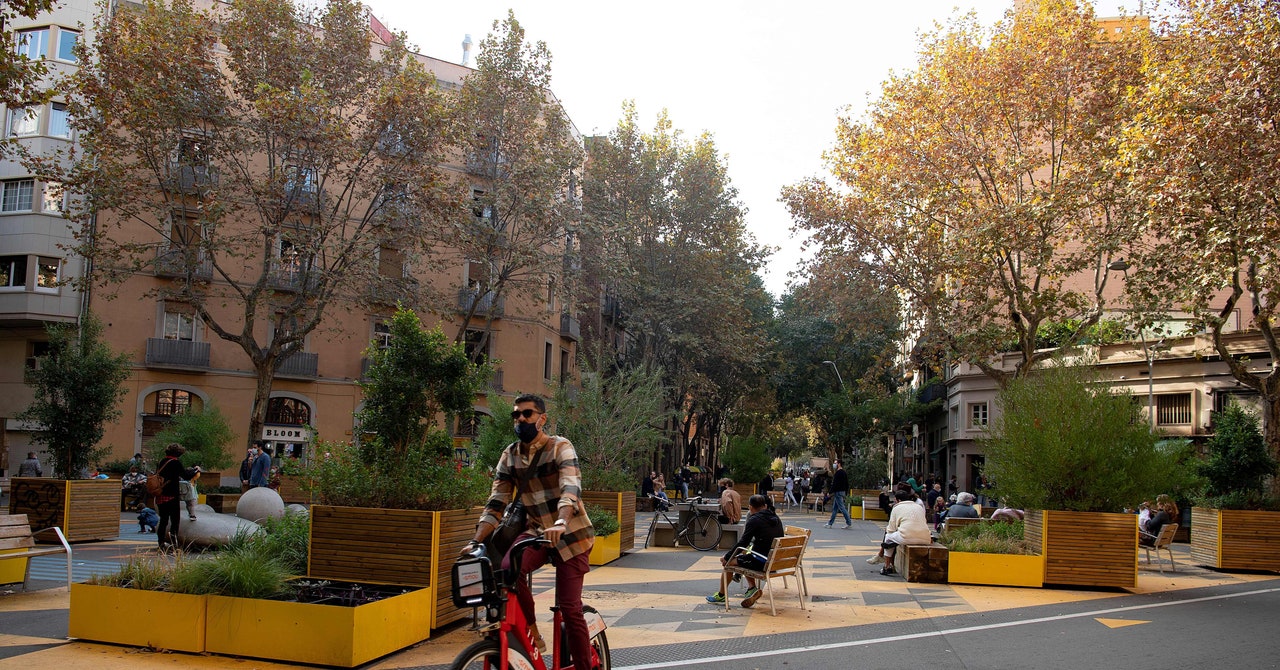I imagine bikes will be very useful in making US cities walkable. The streets have been built very wide to make space for cars, which would make walking more tedious, but bikes are the perfect solution to this bc they let you cover more (flat) distance with just the power of your legs.
deleted by creator
A return to trolleys would also be lovely. A lot of American cities are already laid out with trolleycars in mind.
Oh, I didn’t know this
Yeah, cities in America from around 1870 to 1920 had extensive trolleycar networks. They were so widespread you could hop between them and even travel across state lines. Every major city had them and they were the primary mode of urban transportation. Now cities only have trolleycars as a novelty, like San Francisco still has theirs. New Orleans has beautiful streetcar lines. They’re mostly used for tourists, but if they were made more extensive and modernized then New Orleans could have very functional mass transit.
Most of the trolley networks were ripped up to make room for extra lanes or parking lots. It wouldn’t be easy, but it would be possible to repurpose existing roads for trams/trolleys. I really believe this.
So do I. Yeah a ton of cities used to have them too over here in the UK but very few are still around.
Every two lane road has enough space for four lanes of bicycles (one passing lane for ebikes and one lane for normal bikes going in each direction)
I love this. It’s a simple way to train an open-minded carbrain that there are easy ways to convert existing infrastructure on the cheap!
Due to the pandemic, people needed more outdoor space in cities (since its unsafe to eg eat indoors), so NYC closed roads to cars and turned them into basically public parks.
When the shops started opening again, they city got a lot of pressure and they made a campaign to close I think 25% of the city’s roads to cars in some years
Unfortunately, still not car free
Pressure from businesses and the auto industry lobbyists, I presume.
Imagine if NYC didn’t give in! Imagine if we didn’t give in to corporate interests on the regular. Imagine if we came together to fight for good community-building things…
No I’m saying they already made the comittment. Its what the people wanted.
Ebikes.
People absolutely be going the e bike route.
The only thing keeping me from regularly using bikes or ebikes for short distance travel are the cars and trucks sharing the same space that ignore bike lanes and try to get as close as they can to you when they pass you, and if I try to use the largely unused sidewalks and dip into the street to avoid the occasional pedestrians I get a ticket.
ignore bike lanes and try to get as close as they can to you when they pass you
That’s why protected bike lanes are the ideal, preferably grade separated from the road. Remove the problem via infrastructure, and more people will bike.
Cool article but Wired already published this 2 years ago. Wonder why they’re repubbing?
It is like the U.S. Wired catching up to the idea years later?
Totalled my car three years ago. Never bothered buying a new one. I save a lot of money and accepting my faith when relying on public transport has given me so much mental freedom. I take the train to work and the last part of the route is by shared bikes. Love it.
I don’t live in a car-free city, but I wish I would. Fuck cars and especially fuck the people in them. I live in a pedestrian zone, but connected to the main artery through the city. You would think that labeling something as a pedestrian zone would reduce the amount of cars going through, but no, it’s just a second main street. Might as well take down the ped zone sign, it gets ignored anyway, so why waste money making one?
When we have a pedestrian zone here, there are bollards at each end. It tends to discourage most cars.
Is there a FAQ about living in car free cities? For example, how do you travel to another city? What do you do if the city has high slopes making walking and biking too hard? Or how do elders deal with what other citizens would take for granted in terms of mobility?
how do you travel to another city?
Usually by bus or train.
What do you do if the city has high slopes making walking and biking too hard?
Walking is good for you, biking is not too popular in cities with slopes, but electic bikes are changing that.
Or how do elders deal with what other citizens would take for granted in terms of mobility?
There is definitely less mobility, but that is part of getting older isn’t it? Usually they just walk a bit slower and use busses and taxies.
Wouldn’t the elderly be a huge benefiter of a car free city? You get old enough or frail enough that you can’t drive. Then what?
I like in a city that provides free busses and trains to those aged 65+ if they ride in off peak hours, and it’s heavily used. This is in a city designed around cars.
Or how do elders deal with what other citizens would take for granted in terms of mobility?
Electric mobility scooters as well. I’m sure those are capable of much better range now, and it should keep getting better, and everything they need would ideally be close by
And what about cities with cold winters and tons of snow? 10 minutes outside here is no joke
I’m going to let you in on a secret, even though our Canadian cities are shit for people with a car there are still thousands of people in every city who get by year after year without one, because they can’t afford to buy one.
Not having a car sucks, but it is not a death sentence and would be a hell of a lot better if our cities didn’t assume everyone had one.
Why Canadians Can’t Bike in the Winter (but Finnish people can)
Basically, proper bike infrastructure and snow-clearing make a world of difference. It’s not nearly as bad as it seems if you just put on a coat and get going.
I live in Toronto, and I don’t have a car. I use buses and subways for most of my commute in winter. Along with these options, I use bikeshare (public bicycle rentals) in every other season. There are people who bike even in winter but I’m nowhere close to that hardcore.
I’ve spent maybe $250 on uber in urgent/lazy situations in the last one year - that would’ve been a monthly auto insurance payment.
I waited for a bus for around 20 minutes in -18°C a few weeks back. The biggest problem was that I had overdressed so I started sweating and had to unzip a layer.
An important fact that people who have only ever lived in suburbs miss is that you don’t have to commute thaaat far thaaat often when you live in walkable cities. My cousin who lives in a suburb, drives for ~20 minutes to get to the closest big box store. I have 5 options for groceries in a 1 km radius and one of them is just one block over. So, I don’t even need a bus for groceries, let alone a car. We have seniors who definitely shouldn’t be driving walking around with grocery carts on the sidewalks. So, reducing car dependency improves mobility - not the opposite.
I drove from Dallas to Toronto in 2017 (you know, for fun), and I was amazed not only at how trim almost everyone looked but also at how many fucking people were on bicycles. Coming from the concrete jungle that is DFW, it was genuinely inspiring.
I’m happy to report that the number is cyclists is increasing every year with the addition of more bike lanes and a growing network of bikeshare stations. :)
Something like this?
https://ebikehaul.com/products/q-runner-all-weather-4-wheel-mobility-electric-scooter
It’s still speed limited, it’s not a car.
Edit: that is a tad expensive though, would need to get costs down
Or how do elders deal with what other citizens would take for granted in terms of mobility?
Currently they alll use little electric mobility scooters, in cycle lanes when available, bacause its too dangerous to be any where there are cars here in Australia.
How do those with epilepsy get around, they can’t drive at least they can’t here in Australia. One lady with epilepsy I knew rode a little electric scoot, she loved having her independence.
What happens to people when they loose thier license in the US ?
I couldn’t tell. Barely know the US and it’s been a long time. Those were questions over the top of my head, out of curiosity, and coming from the wrong assumption that these cities were totally car-free with the only exception of emergency vehicles.
how do you travel to another city?
Train, bus, electrical bike, rideshares for the last mile maybe.
What do you do if the city has high slopes making walking and biking too hard?
Get off and walk, use a bike with electrical assistance, use a different type of mobility assistance if i am very physically impaired.
how do elders deal with what other citizens would take for granted in terms of mobility?
See above + Elders are typically more physically able due to having lived a life of regular everyday exery + their everyday destinations are not several miles away + “car free” doesn’t paradoxically mean free of cars, just almost all cars - ambulances are still needed for example - as such if a person is so impaired that no mobility assistance is enough to get them to their destination, then they can still be taxied by help.
What do you do if the city has high slopes making walking and biking too hard?
You shift to a lower gear and go up the hill
public transport of course. buses go uphill you know.
What do you do if the city has high slopes making walking and biking too hard?
skill issue. i live in a very hilly area and when i reach a steep slope i simply bike harder.
this is ableist as hell tbh
There’s wheelchair accessible bikes, but you are actually correct. Good urbanism requires us to take into account not just those who conform to society, but all it’s people. Interestingly an inclusive and accommodating city is also an economically strong one - in the long run more productive potential is freed and less resources are spent on patch-fixing a broken structure (this isn’t why its good to do, but it’s a nice argument to have when you’re talking to people who are afraid that wed be making a better world for no reason other being good people).
This is your reminder to read Invisible Women by Criado Perez
There’s wheelchair accessible bikes
oh damn that’s cool as hell. as a general statement i’m not anti-bike or anything, i am just annoyed at how little care some people here have for those who are less able than they are
Good urbanism requires us to take into account not just those who conform to society, but all it’s people
100% agreed, and i think our rhetoric should reflect that inclusiveness rather than just defaulting to “can’t do it? fuck you”
Yeah the bikes are super cool, there’s lots of different ones too. I once got overtaken by a guy who pedalled with his arms, made me feel like a scrub.
It is a big issue when we don’t plan for those that don’t fit into our ideal of a “normal” person, because when we default to that we default to planning for men - and really planning for no one.
If you’re interested you should look up “gendermainstreaming”. Vienna has a very good manual on it.I think people here get defensive about bikes because they’re used to arguing against carbrained folks all the time. It should also be noted a city designed for bikes and walkability will be easier to travel in for those who have trouble walking, than a city designed for cars, even if concessions aren’t made.

no, she’s right
just a friendly heads up, I think you misgendered the person you were referring to.
oh shit! i feel like an asshole. my bad, i am fixing it
 you’re right, not everyone can use bikes so telling people to use bikes is ableist. genius. you’re a real thinker. they’ll be reading about you in the history books centuries from now
you’re right, not everyone can use bikes so telling people to use bikes is ableist. genius. you’re a real thinker. they’ll be reading about you in the history books centuries from nowno, saying skill issue to people who aren’t able to bike up steep hills when there are other options such as pedal assist is unhelpful and ableist. it doesn’t take being a ‘thinker’ to deduce that.

this is such a silly non-issue to whine at a comrade for. it’s not ableist. obviously if you have a medical condition preventing you from riding up a hill then my comment doesn’t fucking apply to you, idiot
deleted by creator

Use an ebike?
Consider people who are physically impaired instead of dismissing real problems?
There are many forms of personal mobility devices (some are even like speed limited, miniature, single person EVs) that make navigating a car free city easy for someone with impaired mobility.
Getting cars out of the way makes it easier to accommodate many levels of movement ability, not harder.
Yes we agree. So the response is not “its not an issue” the response is that there are alternatives to bikes. I perceived your response as a sort of sarcastic dismissal and I see now I misread the tone and content, sorry.
It’s cool and all, but trains have fixed routes that can’t take you almost everywhere. Of course I’d prefer trains over highways, just stating the current fact. Take for example every city I’ve lived in Mexico: trains never were an option to travel between cities. That’s changing, fortunately.
PEVs are still not very common around here, but that answers some questions. Thanks for your reply.
Trains can take you most places and busses will take you pretty much anywhere trains don’t. Taxis fill the gap on everything else.
Just go travel somewhere like China or Japan or a lot of Europe and you’ll see for yourself.
sensible places have enough railways that trains can practically take you everywhere, used to be that here in sweden we had railways even to teensy tiny villages a lot of the time.
What do you do if the city has high slopes making walking and biking too hard?
E-bikes and regular bikes with good gearing. And walking up slopes generally isn’t too challenging it’s just slow. Infrastructure can help here too by making sure there are paths that don’t go up hills unnecessarily. Fast and frequent public transport provides another option where walking and biking is less viable.
For example, how do you travel to another city?
Trains and buses. Car as a last resort (preferably one that is hired rather than owned, and preferably electric rather than an ICE).
Or how do elders deal with what other citizens would take for granted in terms of mobility?
Elderly people can’t (or shouldn’t) drive either so better walkability = better for the elderly since it gives options to get around without relying on a car. Good infrastructure design can help with disability access, and many disabled people can’t drive anyway.
For example, how do you travel to another city?
Train or car. Car free mostly refers to inner city trips, for special occasions it’s totally fine to use a car (e.g. moving, buying something big, a weekend trip, etc)
What do you do if the city has high slopes making walking and biking too hard?
Bus, ebikes, other types of electric assist stuff, walking. Crazy steep slopes do put a limit on exclusively human powered mobility (i.e. walking and cycling), but those places are incredibly rare.
Or how do elders deal with what other citizens would take for granted in terms of mobility?
A walkable city features amenities close by, plenty of benches to rest, and a solid bus system. There are absolutely no issues for people with restricted mobility. This applies to people with disabilities as well btw.
In fact I would turn that question around: how do elders deal with the requirement to drive a car to get groceries, etc? Isn’t that like super duper dangerous?
Thank you for your detailed reply. I was under the impression that cars and buses were out of the question. This clarifies a lot. Ebikes and electric devices, however, sound to me like something futuristic, probably because I live in latinamerica.
Steep-slope places are not the norm almost anywhere, but they are not really that scarce here. We probably would need to make some technological catch up.
About elders driving, well, it’s common that they have cars although they can’t/shouldn’t drive them. Some younger ones can step in and volunteer, usually family members, but not only. An arrangement can always be made when young people hardly owns a car.
Steep-slope places are not the norm almost anywhere, but they are not really that scarce here. We probably would need to make some technological catch up.
No worries Switzerland and Austria have you covered. Gondolas are only suitable for people and lighter loads, but funiculars can carry a ton of weight and can be built quite steep indeed, Chile has quite a few of them. In less extreme cases there’s good old rack railways. Funiculars are actually the oldest type of public transport in the world, invented before the industrial revolution, back then operated by water power (fill a tank in the top car, it will pull the bottom car up), and rack rail isn’t exactly new. The oldest were built to get stuff up and down from castles. Gondolas of the Mi Teleficero type are quite a bit newer and can reach quite impressive throughput numbers as the gondolas are unhooked from the wire in stations to make it possible to have a fast wire while not having to sprint when getting on (usually they move about at like 1/2 walking pace in the stations but you can also stop them completely for the elderly).
Ebikes and electric devices, however, sound to me like something futuristic
There are kits enabling you to convert a muscle bike (push bike) into an e-bike. If you get one with a torque sensor, then it will detect how hard you push on the pedals and drive the motor proportional to that force. So you still must pedal but it amplifies your effort which preserves the natural feel and control of pedaling. It essentially makes the hills go away; a hilly place becomes a flat place.
That sounds cool. I’d still prefer to take a bus to feel safer in my car-centric town, but one can imagine living somewhere you just fire up your EPV and be gone. I reckon it requires very engaged local authorities.
how do elders deal with the requirement to drive a car to get groceries, etc? Isn’t that like super duper dangerous?
Judging by some folks I’ve seen driving around with oxygen tubes in their noses: They just drive. And, yes, it is dangerous.
Also “car free” doesn’t have to mean literally zero cars allowed, but just build and layout the city so you never have to use one for daily errands.
I live next to a grocery store and it’s literally the best thing ever, grocery trips take 10 minutes max, I only end up using the car on weekends for hobbies or to visit family and friends.
“Car-free cities” gave the wrong idea. I’d call them walk-friendly cities instead, but I guess that ship has already sailed. Thank you for sharing your knowledge and first-hand experience.
The term “city” can actually be confusing too since it might mean the most central district of a metropolitan area, or it could mean the whole metropolitan area. There is some desire to make the most central parts car free in the way you thought (usually street by street in the centre of the CBD etc), but generally the broader area will not be.
I live in suburbia and the grocery store on the edge of my neighborhood is accessible via a dirt desire path. This beats so many of my friends neighborhoods, but these numbskulls couldn’t pour the 20 feet of sidewalk to connect the commercial to the residential, even though the sidewalk has a 2 foot long spur where it should be. 100% car brained.
Still, running to the store on my bike is just as fast as driving, if not a few mins faster.
From what I’ve seen from Not Just Bikes, there’s also car-sharing. There are services to make it super easy to borrow a car for as little as a few hours if you just need to lug some furniture or something.
how do you travel to another city
Car co-ops is one way.
I have a car, but I’m also in one as it gives me access to different vehicle types that I sometimes need.
To get some places here I also need to take a ferry, and walking on and renting a car on the other end can be situationally cheaper.
Why would anyone hate that? To me it sounds like a utopia. I just had to buy new tires for my car @#$%*!
“People don’t want to give up their freedom”
- The older generation
Yeah, what about my property values?? Will someone think of my property valuessss 😭😭😭
Boomers. I was blown away when I went to a city hall meeting about expanding the roads and hearing their hot takes.
After the wave of old boomers (most of the audience) complained about how dangerous the whole world has become that they can’t even take their trash out on the street, they say a walkable city just opens up “more danger”.
To them, walkable streets means seeing more diversity, which is apparently super scary.
It makes perfect sense when you understand modern city design as a form of mostly unconscious but purposeful violence, that pretty much defines the middle class Boomer generation in wealthy rich countries. Structural violence… as far as the eye can see!
US Boomers love that shit, the prison system, healthcare, highway design, the tax filing system the list just goes on and on.
I really wish my parents generation could have just been skipped and instead I had parents from the previous generation who actually fought for something and understood how to defend workers rights.
“Hard times create strong men. Strong men create good times. Good times create weak men. And, weak men create hard times.“
We don’t just want “car-free cities” for the sake of it… We want walkable cities with infrastructure and proximity to needs/wants built with pedestrians in mind
Removing cars from urban areas means lower carbon emissions, less air pollution, and fewer road traffic accidents
Not to mention how much quieter it is.
Don’t know about other Americans, but I would love to be able to have this kind of lifestyle. It’s just not realistic over here due to the infrastructure. It’s not within my power to make the changes necessary for it though.
It can start by advocating for new pedestrian areas in your city or town, maybe it’s only a block, but it’s a start
I lived across the street from a department store, a grocery, some pizza places, a “smoke” shop, video game stores, and everything else I could want on a normal day. It was amazing. I walked everywhere except to work. I miss living there. The main downside was that it was in Florida.
St Augustine?
Nah, it was Orlando, but not the city proper, more like one of the smaller areas around the actual city. Trying not to give too much away, but it was near Altamonte Springs.
Sorry wasn’t trying to have you dox yourself, I actually do know Orlando pretty well so I think I know where you mean
lol, no prob.
Bullshit. I wanted and haven’t found one.
yeah, car-free cities dont exist. what does exist is cities where you can live a normal life without a driving license. though even there this is restricted to parts of the city i think, where the public transport network is dense enough.
There are major cities that have “less car” zones in their center. Basically they just charge huge fees to bring a car into the area. It is definitely a step forward, but it would be nice if it wasn’t “no cars for thee but, yes, cars for me” from the rich.
There are, in fact, some car-free places. But it’s largely due to logistic issues (middle of a rain forest or on an island without a bridge. or stupid narrow streets)
Show me a car free neighborhood and I’ll show you insane real estate prices due to demand.
Then people will point to those prices as proof it’s a “failure” then spend 2-3x what they “save” on housing on auto loans/expenses.
I wanna live in one 😭
Taking suggestions on cities lol!
I’m living a car-free lifestyle, despite holding a license to drive. It’s more freedom than I’ve ever had.
I sometimes make the mistake of driving to college because it’s faster. I’m always way less happy and focused (and sad cause of having to pay for parking). Ebikes are the shit. It’s about 15 minutes driving and a 25-30 minute bike ride.
Been there at times. It’s great not having to pay and worry about a car (done that at times as well). Yet, if you need to move house or get somewhere difficult, you can lease or borrow a car or van. And you can be an extra driver on trips.
Article is paywalled after the first paragraph. Can anyone post the text ?
London had a problem. In 2016, more than 2 million of the city’s residents—roughly a quarter of its population—lived in areas with illegal levels of air pollution; areas that also contained nearly 500 of the city’s schools. That same air pollution was prematurely killing as many as 36,000 people a year. Much of it was coming from transport: a quarter of the city’s carbon emissions were from moving people and goods, with three-quarters of that emitted by road traffic.
But in the years since, carbon emissions have fallen. There’s also been a 94 percent reduction in the number of people living in areas with illegal levels of nitrogen dioxide, a pollutant that causes lung damage. The reason? London has spent years and millions of pounds reducing the number of motorists in the city.
It’s far from alone. From Oslo to Hamburg and Ljubljana to Helsinki, cities across Europe have started working to reduce their road traffic in an effort to curb air pollution and climate change.
But while it’s certainly having an impact (Ljubljana, one of the earliest places to transition away from cars, has seen sizable reductions in carbon emissions and air pollution), going car-free is a lot harder than it seems. Not only has it led to politicians and urban planners facing death threats and being doxxed, it has forced them to rethink the entire basis of city life.
London’s car-reduction policies come in a variety of forms. There are charges for dirtier vehicles and for driving into the city center. Road layouts in residential areas have been redesigned, with one-way systems and bollards, barriers, and planters used to reduce through-traffic (creating what are known as “low-traffic neighborhoods”—or LTNs). And schemes to get more people cycling and using public transport have been introduced. The city has avoided the kind of outright car bans seen elsewhere in Europe, such as in Copenhagen, but nevertheless things have changed.
“The level of traffic reduction is transformative, and it’s throughout the whole day,” says Claire Holland, leader of the council in Lambeth, a borough in south London. Lambeth now sees 25,000 fewer daily car journeys than before its LTN scheme was put in place in 2020, even after adjusting for the impact of the pandemic. Meanwhile, there was a 40 percent increase in cycling and similar rises in walking and scooting over that same period.
What seems to work best is a carrot-and-stick approach—creating positive reasons to take a bus or to cycle rather than just making driving harder. “In crowded urban areas, you can’t just make buses better if those buses are still always stuck in car traffic,” says Rachel Aldred, professor of transport at the University of Westminster and director of its Active Travel Academy. “The academic evidence suggests that a mixture of positive and negative characteristics is more effective than either on their own.”
For countries looking to cut emissions, cars are an obvious target. They make up a big proportion of a country’s carbon footprint, accounting for one-fifth of all emissions across the European Union. Of course, urban driving doesn’t make up the majority of a country’s car use, but the kind of short journeys taken when driving in the city are some of the most obviously wasteful, making cities an ideal place to start if you’re looking to get people out from behind the wheel. That, and the fact that many city residents are already car-less (just 40 percent of people in Lambeth own cars, for example) and that cities tend to have better public transport alternatives than elsewhere.
Plus, traffic-reduction programmes also have impacts beyond reducing air pollution and carbon emissions. In cities like Oslo and Helsinki, thanks to car-reduction policies, entire years have passed without a single road traffic death. It’s even been suggested that needing less parking could free up space to help ease the chronic housing shortage felt in so many cities.
But as effective as policies to end or reduce urban car use have been, they’ve almost universally faced huge opposition. When Oslo proposed in 2017 that its city center should be car-free, the backlash saw the idea branded as a “Berlin Wall against motorists.” The plan ended up being downgraded into a less ambitious scheme consisting of smaller changes, like removing car parking and building cycle lanes to try to lower the number of vehicles.
In London, the introduction of LTNs has also led to a massive backlash. In the east London borough of Hackney, one councilor and his family were sent death threats due to their support for the programme. Bollards were regularly graffitied, while pro-LTN activists were accused of “social cleansing.” It was suggested that low-traffic areas would drive up house prices and leave the only affordable accommodation on unprotected roads. “It became very intimidating,” says Holland. “I had my address tweeted out twice, with sort of veiled threats from people who didn’t even live in the borough saying that we knew they knew where I lived.”
Part of that response is a testament to how much our cities, and by extension, our lives are designed around cars. In the US, between 50 and 60 percent of the downtowns of many cities are dedicated to parking alone. While in the UK that figure tends to be smaller, designing streets to be accessible to a never-ending stream of traffic has been the central concern of most urban planning since the Second World War. It’s what led to the huge sprawl of identikit suburban housing on the outskirts of cities like London, each sporting its own driveway and ample road access.
“If you propose this idea to the average American, the response is: if you take my car away from me, I will die,” says J. H. Crawford, the author of the book Carfree Cities and a leading figure in the movement to end urban car use. “If you do that overnight, without making any other provisions, that’s actually approximately correct.” Having the right alternatives to cars is therefore vital to reducing city traffic.
And any attempts to reduce urban car use tend to do better when designed from the bottom up. Barcelona’s “superblocks” programme, which takes sets of nine blocks within its grid system and limits cars to the roads around the outside of the set (as well as reducing speed limits and removing on-street parking) was shaped by having resident input on every stage of the process, from design to implementation. Early indicators suggest the policy has been wildly popular with residents, has seen nitrogen dioxide air pollution fall by 25 percent in some areas, and will prevent an estimated 667 premature deaths each year, saving an estimated 1.7 billion euros.
When it comes to design, there’s also the question of access. Whether it’s emergency services needing to get in or small businesses awaiting deliveries, there’s an important amount of “last mile” traffic—transport that gets people or things to the actual end point of their journey—that is vital to sustaining an urban area. If you want to reduce traffic, you have to work around that and think of alternative solutions—such as allowing emergency vehicles access to pedestrianized areas, or even using automatic number plate recognition to exempt emergency vehicles from the camera checks that are used to police through-traffic in LTNs (which is what Lambeth is doing, Holland says).
But even then, it’s often just hard to convince people an entirely different city layout is possible. Getting people to accept that how they live alongside cars can be changed—say, with an LTN—takes time. But government surveys of the UK’s recently implemented LTNs have indicated that support from residents for such schemes increases over time. “If you start seeing more and more of those kinds of things, things become thinkable,” explains Aldred. If you start unpicking the idea that car use can’t be changed, “it starts to become possible to do more and more things without cars for people.”
The other issue is that, to put it simply, cars are never just cars. They’re interwoven into our culture and consumption as symbols of affluence, independence, and success, and the aspiration to achieve those things in future. “A man who, beyond the age of 26, finds himself on a bus can count himself a failure,” the British prime minister Margaret Thatcher reportedly once said. “That’s how we got in this mess in the first place, though,” says Crawford. “Everybody saw that the rich people were driving cars, and they wanted to too.”
That divide goes some way to explaining why the opposition to car-reduction schemes is often so extreme and can devolve into a “culture war”—which is what Holland has found in her experience with LTNs. But that struggle also outlines an important fact about car-free urban areas—that once cities make the decision to reduce or remove cars, they rarely go back. No one I spoke to for this piece could name a recent sizable pedestrianization or traffic-reduction scheme that had been reversed once it had been given time to have an effect.
Many of the cities that pioneered reducing car use—like Copenhagen in the 1970s—are rated today as some of the best places to live in the world. Even with London’s experimental and often unpopular LTN scheme, 100 of the 130 low-traffic areas created have been kept in place, Aldred says.
“Generally speaking, if a sensible program is adopted to really reduce or eliminate car usage in a central urban area, it seems to stick,” says Crawford. “If you go back a year or two later, people will just say: well, this is the best thing we ever did.”
Reaching net zero emissions by 2050 will require innovative solutions at a global scale. In this series, in partnership with the Rolex Perpetual Planet initiative, WIRED highlights individuals and communities working to solve some of our most pressing environmental challenges. It’s produced in partnership with Rolex but all content is editorially independent. Find out more.
Thank you very much
Use No script to bypass paywalls. I’d recommend using a seperate browser ya norm don’t use because it can break lots of websites
Thanks for the rec :) I tried one of those extensions a while ago and it didn’t help me so I uninstalled it, maybe I’ll give no script a go. I’ll probably just turn it off and on as needed
To be totally honest a lot of why I appreciate you just pasting the whole thing is cause I’m only ever browsing via my phone and my phone is a decrepit piece of garbage so I don’t usually go to links unless they seem extremely compelling 😅 I probably wouldn’t have read the article had you not shared it in the comments, and I’m glad I read it, it was a good article
Hope you have a good one :)

























